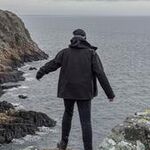Yes, I've seen those videos. The difference between Nova and Polaris burner bell is clear, this might have something to do with it or not. And in videos where there isn't side to side comparison, you can't really tell anything. What is said to be kerosene or paraffin might as well be closer to lamp oil, C13-C16 hydrocarbons.
Polaris was designed to burn LPG also, where Nova is liquid fuel only. There has to be a compromise as we know. Out of the box Polaris fuel-air mixture is spot on for alkylate gasoline (but there are differences between individuals). Raising the flame plate just a little increases air for kerosene but then LPG has little problems igniting... So I think Katadyn wanted to make sure people wouldn't have problems with LPG and that's why out-of-the-box Polaris might burn richer with kerosene. Nova doesn't have to deal with LPG but it can if you just change the hose.
I think this might be just very clever marketing. I haven't got any huge differences in boiling times when all things are equal. I don't know how they came up with that.
Good points.
When I bought my first Nova I assumed it would function as the Polaris. (Cynical as I am, I suspected that the difference between Polaris and Nova would be smaller than Katadyn was painting in the marketing.) So I got myself a 5L bottle of Aspen alkylate 4 stroke, assuming it would be the preferred fuel as you describe for Polaris. I found that the flame indeed was blue, but boil time was unimpressive.
Further testing showed that both my Novas consistently performed better with with BBQ lighting fluid (C10-C13/ EC 918-481-9 ) and lamp oil (within C13-C16). Basically all different fuel in the range C10 to C20 burned flawlessly.
I also concluded that Kemetyl lighting fluid (T-yellow) was producing soot and residue on the burner that I didn't see from other "heavy" fuels. After reviewing the safety data sheet I attribute this to the C8-C26 (fisher-tropsch).
I have seen similar results with "furnace" fuel that contain heavy naphtha. So I have decided to stay in the C10 to C20 range and avoid "naphtha" completely.
It gives my a wide range of easily available fuels that make the stove run basically maintenance free. These (medium) heavy fuels also seem to lubricate the system sufficiently. Connecting the stove to fuel bottle has always been a hustle free experience to me independent of the weather. An issue I have seen raised numerous times among other Nova users.
Interesting finding about the flame plate. I have read about this in some other forum. However, I didn't pay too much attention to it because the flame plate claws are so soft that the plate seem to move around rather generously during normal hike handling.
Have the fuel filter been consistently the same in all of your stoves?
My first stove worked flawlessly and had a brass filter. Same as show in the replacement kit.
However, my second stove felt very restricted and required excessive pumping. Some troubleshooting reveled a very restrictive white "mouse tampon" that I replaced with some fluff from a cotton swab. After that it all worked flawless.
I have seen a number of complaints in forums related to Nova about poor performance, fuel blockage from using lamp oil/paraffin, pulsating. Problems that I suspect might be related to this specific fuel filter.
I hope Katadyn didn't introduce this mouse tampon on Nova to create the marketed performance difference between Nova and Polaris.











